|
|
|

31 December 07: Out with a bang
|
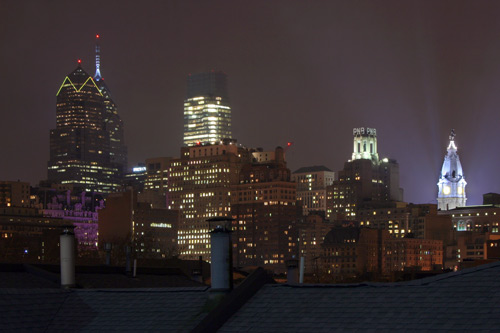
You take a sip, you take a breath, you take a nap, you take a walk, you take a drive, you take a red eye to go, and it's gone daddy gone, gone like two oh oh seven.
Here at yr friendly Philly Skyline, it's been a petal to the metal kind of year, shakin' hands, kissin' babies, runnin' over mailboxes and just tryin' to stay on the up
and up. Sure, there have been a few things that have been blown right by like a scruffy hitchhiker, but as long as we're livin' -- L-I-V-I-N -- there'll be time. Some of
2007's promises will be 2008's promises: The Skinny (ha ha! Seriously!), a new look, better organization and archiving, more neighborhoods, more profiles, more photos,
more events, calendars, chili cookoffs, baseball playoffs, words to live by. It's going to be a rock & roll 2008.
But we can't just tie one on at Penn's Landing under the big exploding sky and skip outta 2007 without a final, official shout-out to the folks who've been along for the
ride. So . . .
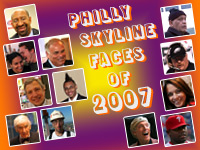 • To Nathaniel Popkin, Steve Ives, Michelle Schmitt, Nidhi Krishen, Michael Shannon and Conor Corcoran: thank you for all your awesome contributions, hard work and
inspiration. Without your efforts, Philly Skyline might have devolved into what I fed my cat this morning. (Aww, I love that three legged cat.)
• To Nathaniel Popkin, Steve Ives, Michelle Schmitt, Nidhi Krishen, Michael Shannon and Conor Corcoran: thank you for all your awesome contributions, hard work and
inspiration. Without your efforts, Philly Skyline might have devolved into what I fed my cat this morning. (Aww, I love that three legged cat.)
• To Joe Minardi, Matt Johnson and Arthur Petrella, thank you for sharing your views of our local world. Here's to more photos, and to anyone interested in
contributing photo essays in the new year, think of some ideas and drop a line to photos AT phillyskyline DOT com and let's talk after the hangovers.
• To Inga, CDoc, DMac, Golas & gang, Cornfield & cohorts, Sweeney, Deeney &
Valania, Albert, Enrico,
Dovate, Illadelph, Zoe Strauss, HughE, Ruby Legs, Gambacorta, Weitzel, and everyone making Philly interesting, keep on keepin' on.
• To Zur in the Northeast, Jimbo in Tampa, DEREK IN OLNEY, Mark & Marcus in G-Ho, Paul in Northern Liberties, Ray in East Falls, Bart in Wisconsin, Barry in
Titusville, Vinny in South Jersey, Tim in Roxborough, Glory in North Philly, John III in West Philly, and all the regular emailers: thank you for being
moved/impassioned/incensed/inspired/affected enough to drop a line.
• To everyone who's emailed that I've failed to get back to in a timely manner if at all: my bad. I'm trying, honest I am.
• To you, my dear reader: thank you very, very much for coming by and coming back.
• To everyone in the Faces Of 2007 photo compilation: say cheese.
Happy New Year, everyone. We'll be back in action just as soon as dem golden slippers are back in the closet with a plate full of newness and goodness. We'll even come to
your emotional rescue.
–B Love
|
 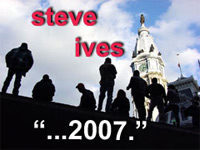 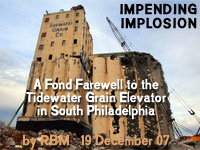 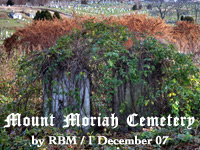
28 December 07: All those little things
The Year in Review by Steve Ives
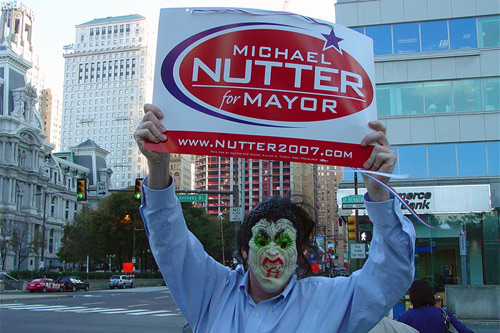
Just by virtue of being the type of person who would visit a website such as this, you're already inclined to be the type of person who notices "the little things". And,
as such, you're aware that the "little things" are never, ever little. The types of things that thousands of our fellow Philadelphians zip, saunter and sashay by on a
daily basis we find worthy of an extra moment of our day. This intended to inform and persuade the uninitiated, the folks who just come and go. You're already inducted
into the faith. So this isn't for you.
Who this is intended for are those zipping, sauntering, sashaying friends, coworkers, family members, bar buddies, baristas and bus drivers who don't notice "little
things"; who don't point out items of note -- "it's just a lamppost" kind of people.
Are you kids listening?
Your friends aren't weirdos. They aren't dull. They don't have some unusual form of OCD (so far as I know). The difference between them and you is that they see the world
through a different lens. They seem to be people who look at the big wide world as composed of parts of a number so vast and overwhelming that our minds and our eyes seem
to stay fixated on the beautiful little pieces.
It's a bit ironic that this situation seems to be so true in Philadelphia, a city so often overlooked and remarkably full of "little things" that sometimes fit so
seamlessly into the urban fabric that you may not ever notice them. Everyone is familiar with the big draws. Our city is known for a decommissioned house of government, a
damaged bell, a weathered stairway and fattening foods. Our answers to Fifth Avenue and The Space Needle. So be it. I'd like to offer that it isn't the big, shiny things
that give any place worth its salt its real appeal. It's not the chocolate chips but what's in the cookie that really gives one that satisfied feeling and it's the kind
of thing that really makes itself evident to those who've walked these streets and noticed the details. What are the little things you may bypass?
Have you ever wasted time in Chestnut Park?
Have you ever taken the time to find every detour off of Locust Walk?
Have you ever sought late night refuge at the Mayfair Diner?
Have you ever spent a Sunday night at Fiume?
Every city has those individual amenities that offer it a flavor unique unto itself and are beyond replication.
You can't manufacture Headhouse Square
You can't recreate Ward Park.
You can't build your own Bainbridge Street.
You can't improve on The Plateau.
Philadelphia has spent so much time looking up at others and down on itself that we collectively not only forget the amazing little things, we can go to great lengths to
minimize their significance - only to find ourselves wondering why our visiting relatives or those Southern tourists seem so fascinated by Belgian blocks and statuary.
Many of us seem to forget this city's past as a literal showcase of the world. During a time that even many of our parents would remember, Philadelphia was counted among
an elite circle of places in which to see, to learn and to do. This city rose to its great success on things that were valued at the time (roaring industry, community
life, apparently religion) and endured a hard fall as some of those things became less central in American life. What was left behind were artifacts from a time of
excitement, of hope, of hard work. We were left with remnants of a great era and became over the course of fifty years the city of, as a friend once put it, American
Ruins (with only Detroit being able to make as legitimate a claim). This all happened at a time when 'the city' was becoming less important, something to cast off,
shunned and avoided. Those left behind, those relative few who refused to leave and those fewer who never felt the need to created a new identity for themselves over time
and the urban landscape largely suffered for it.

Over the past 15 years or so that mentality began to change in this nation and within the past decade this attitude began to seep its way into Philadelphia, slowly
penetrating mindless bureaucracy, deeply ingrained insularity and a culture totally unfamiliar to and totally unwilling to grasp concepts in design, in planning, in
management that are relatively old thinking to the places Philadelphia always wants to compare itself to. What is fortunate for all of us is that this collision of
circumstances puts our beloved city in a unique situation to at last define itself as the post-industrial hangover finally subsides. We're in the unique position of being
as big as we are, with as much as we have and as little as we've had to work. We're in the unique position of being relatively fertile ground for minds that craft the
'little things' that make up cities at a time of a kind of hand-off from 'the old guard' to people who not only have the drive and the vision to create but who have also
taken the time to understand the place they're putting their hands into. In other words, this city is a most wonderful template. We aren't a scratch-build Sunbelt city
and we aren't a place that gets our every thought and action modeled by every place that's trying to be someplace (and thank goodness for that). We're that old
house with the sturdy stairs, the thick walls and the fireplace. We've got the 'little things'. We haven't yet obtained much of that outward glamour but people are
noticing the new windows. And what I would like for you, the too-busy-in-the-day-to-day type, to do just once (and pick a nice day to do it - in April when the Phillies
are contractually obliged to suck but before the football draft) is to not ignore the magnificence of your surroundings. Spend an afternoon, pick an area of the city you
never visit and go for a walk. Need a beer? Put it in an iced tea bottle and go out but go out and take the time to observe what's brining all 'these new people' here.
Rediscover the Philadelphia of your parents' day. Much of it is still largely there.
The big slide at Smith Playground is still there.
You can still get ribs at the shack on Weccacoe.
It's possible to take a trolley to The Zoo again.
You can still see the world from the 23.
I'd like for all of us to be a bit more appreciative of all the little things that compose our city. The little things get very little press, draw very few tourists and
make it into very few brochures. It's those little things that are valued by regular people that maintain the soul of a city. It's that soul that gives a city its appeal,
its outward glamour because as its residents feel that they inhabit an important place, even if its only important to them, it begins to rub off. It becomes less
transient or at least leaves a more indelible mark on people who pass through it. Everyone who's ever lived in and left New York -- even if they hated it -- can point out
something unique to their experiences that they'll tell countless times at countless gatherings (even if its roaches). I would hate to think that people who live in and
leave Philadelphia leave with nothing more than memories of sad or ineffectual things. A lot of residents walk around with that same viewpoint and it's a little thing
that doesn't help us much. There are plenty of things about being a Philadelphian that get rightful scorn but the little bonuses can be enough to soothe a sour moment. If
you notice enough of them this will become an easier place to love. It takes time and a patient eye and you'll never cover it all. But take a moment every now and then.
The little things create the day and are what life in Philadelphia is all about.
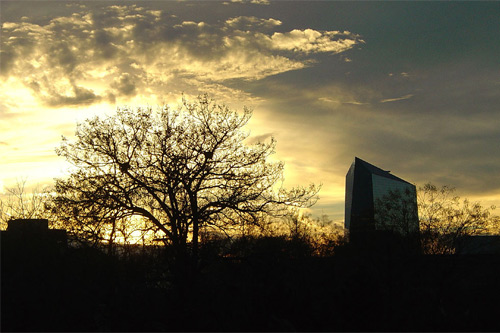
–Steve Ives
phillytrax@aol.com
For more from Steve Ives, please see his archives HERE.
|
   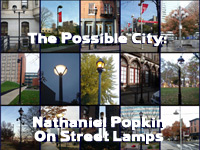
27 December 07: High Tide:
Last Days of the Tidewater Grain Elevator
|
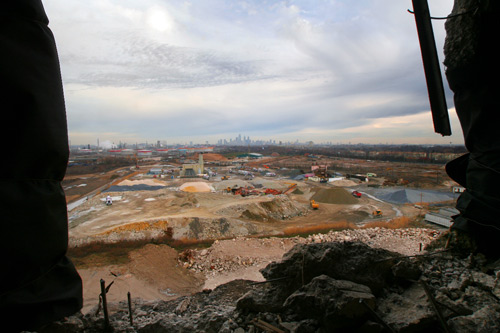
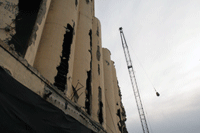 The Tidewater Grain elevator is no more. The most notable -- and noticeable -- post-industrial relic left in South Philadelphia bit the dust early on Sunday
morning. Speaking of which, I must apologize to the folks I suggested watch the implosion from the Platt Bridge. I had no idea they would be closing both it AND the
Girard Point Bridge during the implosion. If you went, I sincerely hope you were able to catch the view.
The Tidewater Grain elevator is no more. The most notable -- and noticeable -- post-industrial relic left in South Philadelphia bit the dust early on Sunday
morning. Speaking of which, I must apologize to the folks I suggested watch the implosion from the Platt Bridge. I had no idea they would be closing both it AND the
Girard Point Bridge during the implosion. If you went, I sincerely hope you were able to catch the view.
The history and existence of the Tidewater Grain elevator and complex has been well documented; please see Jessica Chiu's April 2004 essay for the Philadelphia Independent and Workshop of the World for the best of the back story. For our purposes, though,
we'll look at its final days.
CDoc, the mind behind The Necessity for Ruins, rolled into Johnny Brenda's a couple weeks ago as Matt Johnson,
the mind behind Skyscraper Sunset, and I were having a beer and talking about the year 2008. Doc told us he'd
heard about the impending implosion of the Tidewater Grain elevator. Matt and I each knew the structure he meant -- anyone who's ever been across I-95 or the Platt Bridge
would -- so we were intrigued, but none of us knew too many details about the elevator OR its implosion.
A week later, Doc has us meeting him, two other enthusiasts, and a fellow named Harry with a white F150 at ground zero. Harry is the superintendent of the site now owned
by Camden Iron and Metal, whose expansion across the river from their Jersey home necessitated the clearance of the land on which Tidewater Grain's elevator stood. He
graciously allowed us to tour the site and structure a mere four days before dynamite would bring it down.
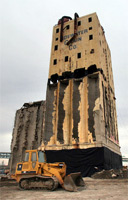 By the time of our arrival, wrecking balls had partially demolished the exteriors of several of the silos built in 1913 to withstand explosions, a problem with mass
storage of highly flammable grain. The main tower was still standing, though, and workers from Camden were busy preparing the extremely thick walls for the blast and
installing aprons to retain debris and shrapnel. Generally speaking, Harry advised us to not die. I am happy to report that none of us did.
By the time of our arrival, wrecking balls had partially demolished the exteriors of several of the silos built in 1913 to withstand explosions, a problem with mass
storage of highly flammable grain. The main tower was still standing, though, and workers from Camden were busy preparing the extremely thick walls for the blast and
installing aprons to retain debris and shrapnel. Generally speaking, Harry advised us to not die. I am happy to report that none of us did.
We walked around the perimeter of the site, wrecking ball a-swinging, and into the tower where we had to mind the giant manholes in the floor which no longer had their
covers, protruding rods and cords, and lots of loose concrete debris. To get to the upper floors, we were told we'd have to go single file up an old spiral staircase that
none of us could immediately find; that's because it was hidden in a tube that looked like the building's support columns. (Matt has some great photos of the stairs on
his site HERE.)
A good 150' climb later, we were on the upper floors with more debris, more rods and wires, more manholes, no railing on any of the windows or open walls, and on the top
floor -- the one with the single, half-mounted ladder to the rooftop (which also had no railings) -- a whole lot of seagull guano. A little precarious, no doubt.
The following photos, like many of the other photo essays on this site, are a combination of the work in progress and the views along the way. It's a unique perspective,
being 245' above an enormous brownfield situated between two major bridges, an oil refinery, a shipyard, and airport, and a cruddy, gritty portion of the same river that
just a few miles upstream is the subject of postcards with rowers, bridges, and skyline views.
Don't forget to check out CDoc's photos HERE and
Matt's photos HERE. Doc was also on hand to film the implosion, video YouTube'd HERE.
–B Love
|
26 December 07: For your consideration
  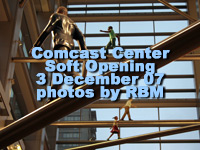 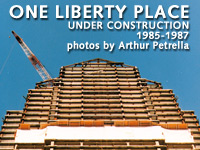
26 December 07: Old and in the way
(All images in this entry are click/enlargeable.)
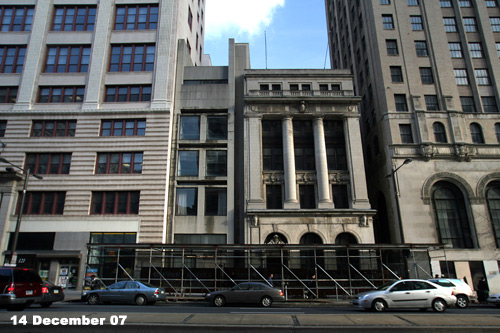
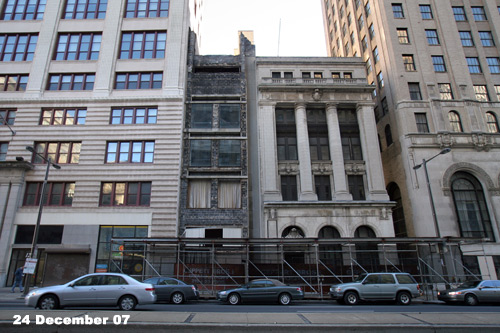
Sheesh, I go away for 4-5 days -- over the holidays no less -- and I come back to learn that the Philadelphia Life Insurance Company (PLICo) building and its
annex at last received official protection by the PA Historical and Museum Commission (hooray!), then its demolition by PA Department of General Services
(overseeing the expansion of the Pennsylvania Convention Center (PCC)) began anyway (gasp!), then the Commonwealth Court of PA stepped in in an emergency to
prevent further demolition (hooray!).
That the demolition conversation got this far is curious enough, when one considers the agreement to keep the two buildings intact as part of the gluttonous,
expensive expansion was signed three years ago, and since the official renderings by PCC architecture triumvirate Thompson, Ventulett & Stainback, Vitetta
Group and Kelly/Maiello all (still) include them. Look at photos 6 & 8 on the Convention Center's official web site on the expansion HERE and this photo on paexpansion.com, a web site owned by PCC Authority and pointing to the same web host. Even curiouser that preservation architect
Hyman Myers, who has overseen restoration work on City Hall and the Academy of Music, approved of the demolition of the PLICo buildings, as reported by Inga
Saffron in Sunday's
Inquirer.
Mr Myers has a stake in the expansion as a stockholder at Vitetta, yes, but does
his approval of the demolition of the PLICo buildings stem from a higher view of architectural salvage? If so, that's a problem. Not every building in
Philadelphia is Independence Hall or City Hall or the Academy of Fine Arts or the PSFS Building or One Liberty Place. Fair enough.
But it's the everyday building stock -- which has been so well documented as such -- that makes Philadelphia Philadelphia. The explosive growth of this city after
the Civil War and into the 20th century, when we were the Workshop of the World, built
the city's breadth into South, West, North, Northwest and Northeast Philly, and in Center City, the offices and banks and companies that propelled that breadth
built their own temples. Like the Philadelphia Life Insurance Company's buildings.
These are not marginal buildings, and they are not relics. They are entries in the living museum of this city. The thread of history incurs voids when less
notable, but still important buildings, are demolished: Convention Hall in West Philly, the Front & Chestnut maritime buildings, the Adams Mark Hotel on City
Line, Furness' 1600 block of Sansom Street, Byberry Mental Hospital and the Sears & Roebuck complex in the Northeast, the Naval Hospital and Tidewater Grain
elevator in South Philly. (Tom Keels wrote an entire
book about the lost architecture of the city.) And maybe, the PLICo building and its annex.
Adin Lacey's five story neoclassical/beaux-arts building from 1915 with arches, columns and balustrades was a subtle, but honorable, home for the Philadelphia
Life Insurance Company. Romaldo Giurgola's addition in 1962 brought the company into the modern(ist) era with intentional contrast, not unlike Cira Centre at 30th
Street Station or the addition at Soldier Field in Chicago or the Hearst Tower in New York.
The Convention Center Authority apparently understood this when it signed its Memorandum of Understanding to keep the buildings, and the (state) Historical
Commission, acting on behalf of the (city) Preservation Alliance, definitely understood it. It's the (state) Department of General Services (DGS) that apparently
did NOT understand, nor care about this, claiming that since it was not party to the agreement, it didn't have to abide by it. (Pardon my train of thought here,
but I would think that since DGS came on after, it would have to act on the agreement.) So, the day after the Historical Commission said "save em",
DGS said "nope, crush em" -- at 4:30pm. On a Friday. Of Christmas weekend. Nothing shady about that.
So, Saturday morning, DGS's contractor, Geppert Brothers, Inc, did exactly what their client ordered them to do: start demolishing the buildings. (For more on
Geppert Bros, check their web site Myspace.) They started with the annex,
a clear sign of spite. It didn't take them long to strip the entire building of its limestone façade.
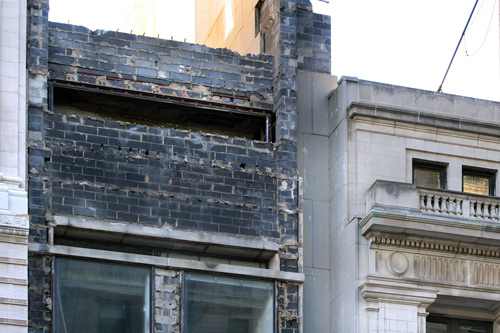
Damage is done, yes, but despite the appearance of the exposed, blackened cinderblock, the annex is not entirely unsalvageable. (It would need to be
reconstructed, though. Bill the ones who shouldn't have ordered its demo in the first place.) News of the suspicious demolition spread like wildfire and made its
way to Design Advocacy Group, who had worked so hard to raise awareness of the two
buildings (along with the Preservation Alliance and indeed Inga, whose work on this subject over the past few months cannot be understated), and on Monday the
Commonwealth Court ordered a temporary injunction banning further demolition until a hearing on the matter can be held in Harrisburg. It is scheduled for January
8th. Plan Philly has a copy of the injunction HERE.
Who ordered the demolition? How was it carried out?
"Hello, Geppert? This is DGS. We know you're not scheduled to work tomorrow, and we know that the Historical Commission said not to demolish those buildings, but
we'd like you to do both."
Something like that?
Where has Mayor Street been in this? Just kidding. Really though, what does incoming Mayor Michael Nutter, who sat as the head of the Convention Center Authority
for so long, think of these two buildings?
An aside item in this conversation is that the Preservation Alliance generally isn't in favor of the façadectomy (as with that of the Rittenhouse
Club on 10 Rittenhouse Square), but in the case of the PLICo buildings of North Broad Street, it was the streetscape those façades shaped that was most in
jeopardy.
Look at the Avenue of the Arts. The blocks immediately south of City Hall -- a short walk through the north-south portal and courtyard from the PLICo pair
-- are vintage big city, what a well crafted streetscape contributes to a city and its community. That the Center City night light show was such a hit here is no accident.
Avenue of the Arts, Inc (AAI) covers the nearly four mile long stretch of Broad Street from Glenwood Ave in the north to Washington Ave in the south; three
quarters of that is north of City Hall, but South Broad Street understandably gets the glory of AAI's work. Streetscape is not some buzzword to AAI, it is
a very real, tangible quality of life issue that was one of its first initiatives. Better sidewalks. Planters. Street lamps.
While Temple has taken strides to embrace North Broad Street with a grand entrance to the Liacouras Center (designed, interestingly, by Vitetta Group and
Thompson, Ventulett & Stainback) and the insta-boost Avenue North, the larger context of North Broad in that same area (City Hall to Glenwood Ave) is spotty at
best. For every Divine Lorraine, there's a Wilkie Subaru; for every Roman Catholic High School, a parking garage.
North Broad Street has enough holes and failures that it seems counterintuitive to bring down such a piece of the city's growth and success. Never mind the poor
Odd Fellows Temple (aka Auerbach Building, by Hazlehurst & Huckel, c. 1893) -- that's been resigned to death since the expansion papers were signed. The Liberty
Title and Trust Building (aka City Place 101) on the corner of Broad & Arch (the one with Dunkin Donuts) will stay, allegedly to become a hotel some time down the
line.
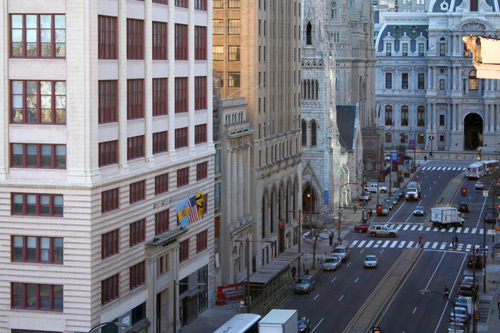
Everyone accepts that the Convention Center is expanding. But, discussions about it can go a number of directions, from its very necessity, to who's building it
(union vs non-union, minority-owned contractors), the hotels it stands to spur, its design . . .
This web site opined (7 November 07: It's Mayor Nutter Jelly Time) that if Mayor Nutter truly wishes to
prioritize green construction in Philadelphia, it will take a mandate, a giant benchmark initiative, to get it off the ground and make people believe. The
Convention Center's expansion covers nearly four city blocks. That's a lot of roof space. This could be that mandate.
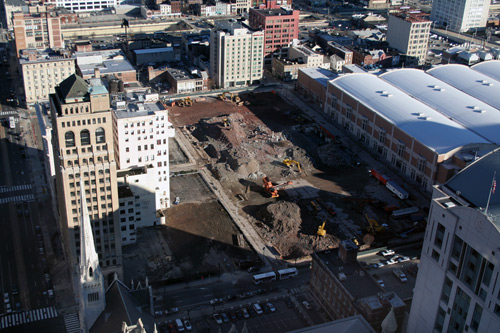
(From City Hall tower, 12/24/07.)
Steve Ives' January photo essay of these four blocks was called In the Way of Progress.
We knew about Buck's Hardware and the Pleasure Palace and the Race Street car wash coming down. The Gilbert and Metzger Buildings, each of the late 19th century,
are already piles of rubble. (See above photo.) But, we sure didn't know just how in the way the two little protected PLICo buildings were.
Stay tuned for more -- January 8th is right around the corner.
For further reading:
• Inga, 12/22/07:
Convention Center told to save buildings
• Inga, 12/23/07: Ruling
aside, center razing 2 buildings
• Plan Philly, 12/24/07: Court stops demo on N. Broad
• Inquirer, 12/25/07: Court stops two building demolitions (Michael Matza)
–B Love
|
26 December 07: Like a setting sun
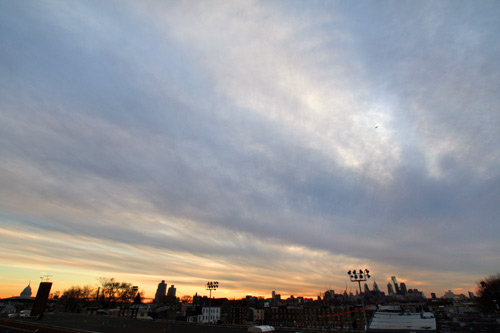
Well hello, how do you do? Santa Claus treat you all right? The Philly Skyline Christmas Skyline just rolls in like upside down ocean waves of rainbow mashed
potatoes o'er yonder Fishtown, dunnit? That little birdy is diving up for a taste!
Okie then, here's what we're looking at for the big three construction jammy jams:
COMCAST CENTER: We're up to approximately eight million photos of Philly's tallest building now, and that number will continue
to grow until the building is officially open (likely in May), as opposed to partially open, which this web site reported on December 3rd (3 December 07: Rise and shine, Comcast Center) and which the Inquirer discovered on Saturday (which also incorrectly reported the 975' tower as 973' -- a piddly
error, yes, but an error all the same). In this Christmas-happy update, take note of the completed scrim wall inside the crown and new posters in the
concourse area. Wow, is that a dorky thing to say.
Go to Comcast Center.
MURANO: Murano's glass appears to be complete, and the mesh steel panels for the crown are beginning installation. All told,
Murano is a very handsome tower, but the parking garage for it just abominable. (Like the snowman.) It's enormous, white and ugly, its entrance is directly across
the street from the entrance of another garage serving both Commerce Square towers, and up top it's set back from JFK Boulevard just far enough that
nothing can ever be built there. It's also the last thing you see when riding any of Septa's regional rail lines into the tunnel to Suburban Station. Great
tower, horrible garage.
Go to Murano.
RESIDENCES AT THE RITZ-CARLTON: We're up to the 28th floor on this tower now, and it's visible from many points north,
including I-95 and the roof of yr Skyline headquarters.
The dark tinted glass is up to the 9th floor now, and depending on which way you're facing it, either has
horizontal spandrels, vertical mullions, or neither. Kinda weird, but kinda cool.
Go to Residences at the Ritz-Carlton.
Also note: as promised, our 10 Rittenhouse Square feature is slowly (very slowly) assembled, slower even than the laborers working on site. Those dudes have this
building up to the second floor already.
UPDATE: Hi, I'm an idiot. Forgot to include links to the sections for the three buildings relayed above. Fixed.
–B Love
|
   
25 December 07:
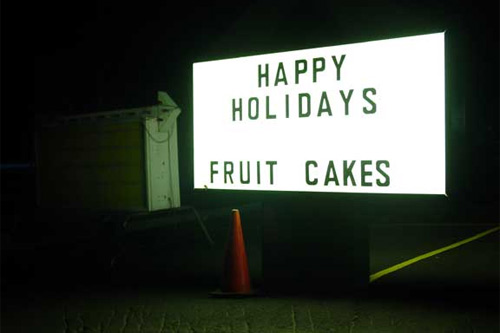
(Actual photo taken in Altoona, Pennsylvania.)
Back on the scene tomorrow with an egg nog hangover and thoughts on the Convention Center's Christmas gift to Philadelphia, Tidewater Grain photos,
Comcast/Murano/RATR-C updates, et cetera, et cetera. Merry Christmas, Skyline buddies.
–B Love
|
20 December 07: Hazy shade of winter
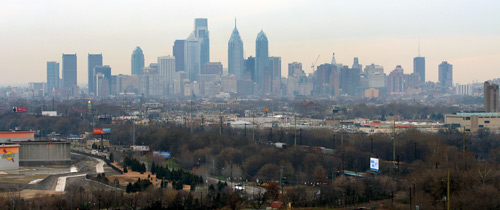
All righty then, Skyline friends, fans, foes and lovers, this 'ere site is gonna take a nice long holiday weekend up in them thar hills where they're still
building "interstate" highways, so you have yourself a real nice weekend and enjoy
the Philly Skyline Tidewater Skyline above. A full series of photos from the visit to that site will be up early next week, as will a 2007 in review essay by
Steve Ives, but before that happens, the Tidewater Grain elevator will be imploded. Be prepared: it's Sunday morning at 7, and the best viewing area is the
pedestrian walkway on the south side of the Platt Bridge.
Peace out on earth and happy winter!
–B Love
|
   
20 December 07: Here I sit, broken hearted
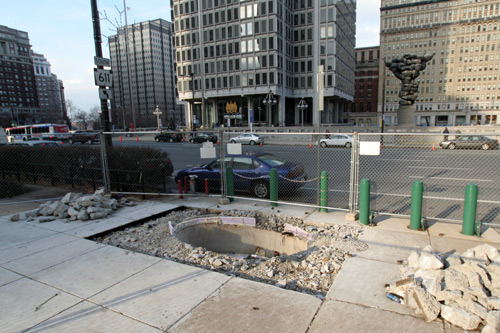
Well, so much for the City Toilet, huh? With no fanfare (at least none that matched its opening), the Wall USA company has removed the well-used City Toilet on the north side of Dilworth Plaza at City Hall.
But fret not! The City Toilet idea is not dead, nor is the ambitious plan to sprout many city toilets.
This particular toilet, the pilot to the City Toilet program, was removed because it was on loan from Wall USA. Wall USA was one of the three companies (Clear
Channel and CBS being the others) who bid on the RFP that included pay toilets for the street furniture initiative that also included advertising on public
benches, trash cans and bus shelters, among other things. Wall USA did not win that bid.* Their toilet was to be a six month loaner that ended up staying
for over a year, and now they've taken it back to their home city of Boston, which already has lots of public toilets installed.
*But then no one has officially won the contract, because the initiative has not passed through City Council for approval yet, because City Council has shelved
everything until the Nutter administration takes over.
After the dust has settled on the mayoral transition, the street furniture initiative will become a top priority, but one met with significant scrutiny, in
particular by SCRUB, which has long fought against billboards and the assault of advertising on the
streetscape. There is a balancing act to providing services like public toilets and the display of advertising which pays for them, but Department of Public
Property Deputy Commissioner Frank Punzo believes this initiative has it, as does Center City District's Paul Levy (as reported by Joseph Slobodzian for the July 17 Inquirer).
Punzo said that Clear Channel's proposal went as far as presenting a bike sharing option (think PhillyCarShare, only with bikes . . . or think the Amsterdam &
Copenhagen bike programs, only in Philly). "This also includes new bike racks across the city," he says, pausing to qualify, "without advertising on them." The
early phase of a bike sharing program would find nodes in well used and strategic locations like the River Drives, Center City and transit hubs like 30th Street
Station.
The revenue stream the street furniture will generate for the city is a no-brainer, but the quality-of-life issue of more advertising is a big one. That
said, the other portions of the street furniture initiative -- even benches and kiosks -- can conceivably be done tastefully, and SCRUB will no doubt see to it
that they are. As well, the Center City bus shelter art installations will be retained.
Presuming the street furniture initiative passes City Council (it probably will), the winning bidder will be awarded a contract whose length the city would like
to be (and which the RFP called for) 20 years. Not including the administration transition, Punzo says the first stage of the project will be phased in over 18
months to two years, over which time new bus shelters, trash cans and so forth will be installed.
And, most importantly!, city toilets. Eight of them, including the important and symbolic original City Hall location, will be installed in the first phase of the
program, with dozens more planned across the entire city, including some in Fairmount Park and at neighborhood nodes like 52nd & Market in West Philly and Broad &
Cecil in North Philly.
The toilets are coming (back); they're just, like so many of us, eagerly awaiting the Michael Nutter administration. Till then, you'll just have to hold
it.
* * *
For additional reading and varying points of view on the subject, please see the following:
• Phila.gov: Dept of Public Property
• Issues Philadelphia: A trashcan that generates cash?
• Phila Economy League: When nature calls
• SCRUB: On street furniture
• Phillyblog: Public
Ads: revenue or aesthetics?
–B Love
|
   
20 December 07: Holiday guilty pleasure
I'd like to start this post by apologizing to my 21 year old self, in whichever parallel universe he may be, any ardently anti-corporate American hippies in West
Philly group homes and especially the proudly independent baristas I call friends. (And perhaps to common decency for the blogginess of this entry.)
Because well, when winter rolls around (as it does this Saturday, December 22nd), staying out of Starbucks becomes impossible. All those people walking by with
their red cups of the crack-coffee products so strong and flavorful it should be (and probably is) illegal, the aroma attached to the swift warm breeze you catch
passing by the door opening to any of the 83 Starbucks on a cold day in
the city . . . the damnable evil allure is insurmountable. (Although I still refuse to say words like "grande" and "venti" . . . they are medium and large,
thanks.)
Specifically, a black cup of the holiday blend and a soft gingerbread scone with raw sugar on top . . . I hate that I love it, but I love it, so I take a deep
breath and step inside, hoping to get in, get my fix and get out quickly without a trace. But Bubba, there's a trace, a paper trail, and a long one at
that.
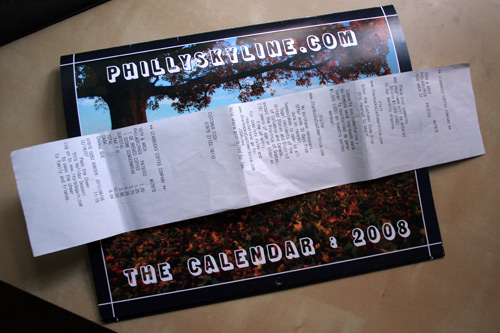
Is this just a Philly thing? Does Starbucks give these receipts for every coffee purchase everywhere? Why am I given any receipt for a effin coffee? Mitch
Hedberg, if you please:
|
19 December 07: B Love in an Elevator, or,
Coming attractions / Calendar of Implosion Events
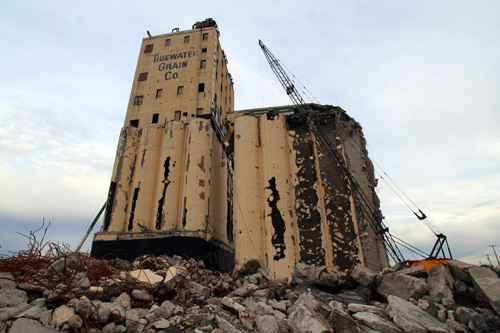
If you're the industrial relic type and you've ever driven/ridden across the Girard Point or Platt Bridges, you know exactly where this enormous South Philly
structure stands. For now.
The Tidewater Grain elevator is scheduled for implosion this Sunday morning at 7, so plan ahead to get up at 5:30, hit the Penrose Diner for a short stack with a
side of pork roll, and hike ye up that Platt Bridge for optimal viewing. Still no lasers and rock & roll music, but at least we know about this one in advance.
(The next one of any significance will be West Philly's Mantua Hall, slated for early 2008.)
Jessica Chiu wrote a nice piece on Tidewater Grain for the short-lived but excellent Philadelphia Independent, and Workshop of the
World (which you should already have bookmarked -- that is one great web site) has a nice historical overview of the site.
Camden Iron & Metal, which owns the site, is tearing down the 93 year old silo and elevator structure to
make way for an expansion of their operations based in, uh, Camden. Its site location at the mouth of the Schuylkill River with piers already built make it
ideal for the expansion, but the Tidewater Grain elevator is in its way, so go have a look
while you still can.
I'll have my photos from a ridiculously dangerous, precarious and death defying visit to the site this morning up some time soon, but keep an eye
on The Necessity for Ruins and Skyscraper
Sunset, cos I bet they were there too. (Big thanks to CDoc and Harry who drives the Ford F150 with Jersey tags.)
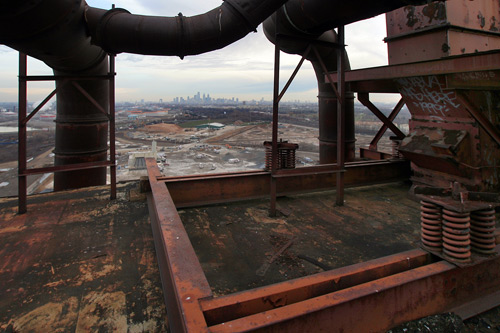
–B Love
|
   
18 December 07: Kimmel's in bits
And now, in honor of last night's Hall & Oates holiday homecoming, seven Philly Skyline Kimmel Skylines for your kaleidoscopic, curvy, Viñolic viewing
and/or desktop/wallpaper pleasure. Clickenlarge x 7. Please enjoy.
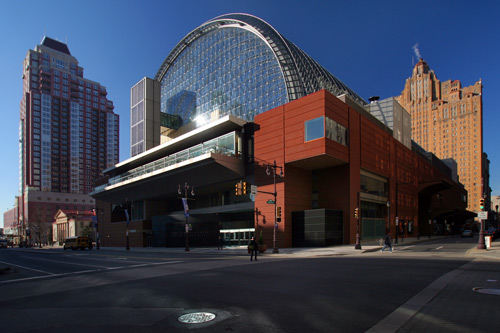
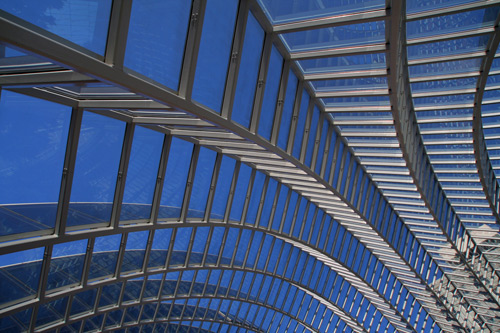
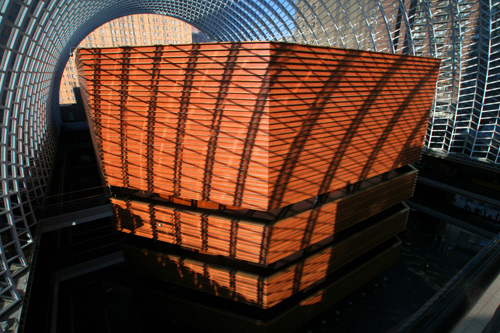
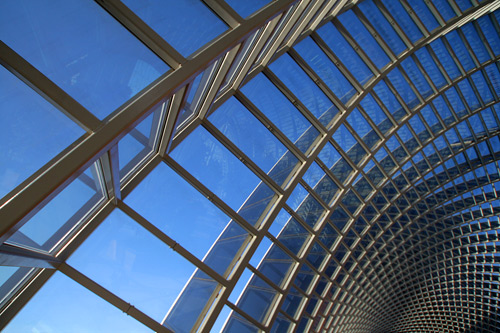
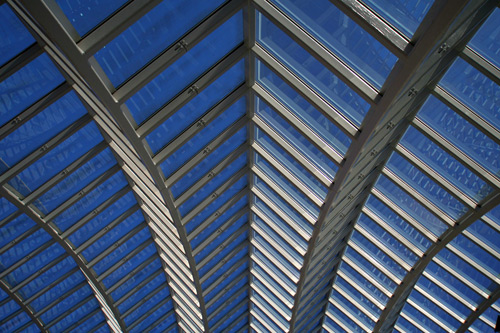
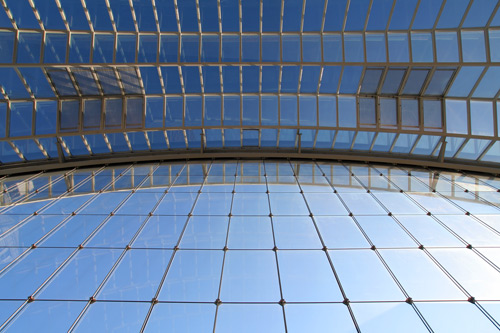
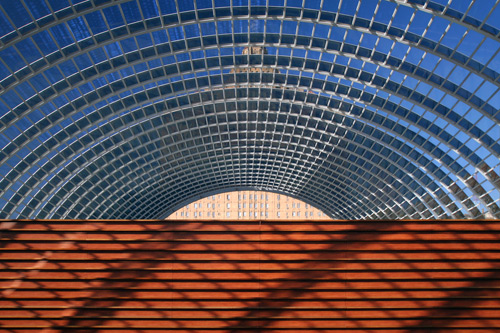
–B Love
|
18 December 07: The Philly Skyline Book Review
Coltrane: The story of a sound, by Ben Ratliff
Coltrane: The story of a sound, by Ben Ratliff
Farrar, Strauss and Giroux, 2007, 217 pages
ISBN-13:978-0-374-12606-3
Reviewed by Nathaniel Popkin
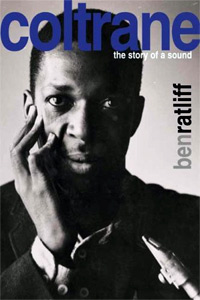 It may be sacrilege to place John Coltrane and Dick Clark in the same sentence, but then I've just done it. Really, it's Philadelphia, as any reasonably complex
city, that puts divergent bodies in motion. In the spring of 1957, as Louis Kahn, with Ian McHarg as lead landscape architect, was preparing the initial design
for the Richards Medical Research Building at Penn (the first designs were presented in June), Clark, sensing opportunity, began pushing hard for ABC-TV to
broadcast Bandstand nationally, which they did beginning in August. It may be even more provocative to place Lou Kahn and Clark together, but for each man
that spring West Philly was his oyster. Kahn, who composed architecture as a form of music, saw the Penn project as a breakthrough multi-disciplinary approach to
medicine (Penn and Kahn apparently were avant-garde: now 50 years later the concept is embraced in Jefferson's Hamilton Building). Clark, the false naïf,
saw gold in teenage longing -- and disturbing talent in the filth of South Philly.
It may be sacrilege to place John Coltrane and Dick Clark in the same sentence, but then I've just done it. Really, it's Philadelphia, as any reasonably complex
city, that puts divergent bodies in motion. In the spring of 1957, as Louis Kahn, with Ian McHarg as lead landscape architect, was preparing the initial design
for the Richards Medical Research Building at Penn (the first designs were presented in June), Clark, sensing opportunity, began pushing hard for ABC-TV to
broadcast Bandstand nationally, which they did beginning in August. It may be even more provocative to place Lou Kahn and Clark together, but for each man
that spring West Philly was his oyster. Kahn, who composed architecture as a form of music, saw the Penn project as a breakthrough multi-disciplinary approach to
medicine (Penn and Kahn apparently were avant-garde: now 50 years later the concept is embraced in Jefferson's Hamilton Building). Clark, the false naïf,
saw gold in teenage longing -- and disturbing talent in the filth of South Philly.
Having already been invited in and discharged by Miles Davis, Coltrane came home to 33rd Street in the Strawberry Mansion section of North Philadelphia (his family had moved there from North
Carolina when Coltrane was 16), to dry out. As much of the jazz world, he was a heroin addict. And heroin was about to wreck his career. Inside that house
facing Fairmount Park he went cold turkey.
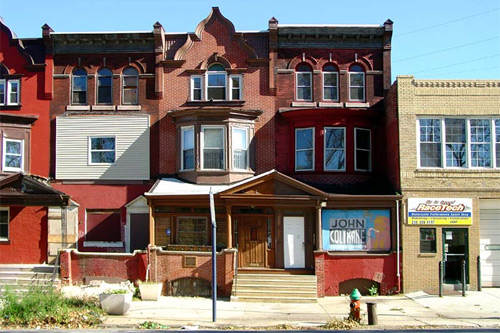
As Ben Ratliff, the New York Times jazz critic, explains in the nearly-perfect Coltrane: The story of a sound, "his periods of greatest clarity and
ambition came when he was not only off drugs and alcohol but emotionally focused." In fact, Coltrane accelerated starting that spring. Thelonius Monk hired him
to join his quartet, then Davis again before the tenor saxophonist formed his own quartet in 1959. In the six years that followed, Coltrane formed his sound --
and that was before the last two years of his life when having exhausted his horn, he leapt fully out of bounds.
Yet Ratliff's book isn't traditional hagiography. In the introduction he says it's more critique than biography, but I see it as something more akin to the music
itself. Here, Ratliff describes Coltrane and Wayne Shorter experimenting.
Later, they talked about improvising and language, and how it might be ideal to start a sentence in the middle, then travel backward and forward, toward both the
subject and the predicate, simultaneously.
This is just the author's challenge in describing the evolution of a sound. It can't be told temporally or even thematically, so Ratliff masterfully does both,
as if he's playing one with the left hand, the other with the right. This is a wise and fluid book, dotted, as is any story of jazz, with people (so many names),
dates, concerts, and clubs. Nothing lasts long and history is made in an instant. What I like so much is Ratliff's range -- from Ravel to Stravinsky, Robert
Lowell to Amiri Baraka, Jane Jacobs to Kant, Akbar Ali Khan to Mantle and Maris, Henry Miller, and the Bay of Pigs -- while never resorting to cliché --
not once is "cat" used to describe a jazz figure. He doesn't employ these people as mere context either, rather to illuminate the essence of his subject, who was
at once the symbol of Black Power and a hungry polyglot in search of universal theory.
He had peace, and time to practice continually, on many instruments: besides tenor and soprano saxophone in the house, he had Eric Dolphy's flutes, bagpipes, a
harp, various drums, and an acoustic guitar. He was still using charts and graphs, based on math and astrology and architecture, to inspire composition; he had
even found ways to derive song from the shape of a cathedral.
(It's instructive to think about Coltrane making architecture from music and Kahn making music from architecture -- and both men drawn simultaneously to south
Asia.) I fell for Coltrane as a college student living at 42nd and Walnut, spending hours listening to those orange and black Impulse CDs in the music store that
was in the basement of Houston Hall. A Love Supreme filled the tall ceilings of my room and haunted my nights. But I couldn't have told you why. "The
point to be drawn from this," Ratliff says as if to answer, "is that a musician can project his will on anything; harmonic restrictions and complicated structure
can coexist with simplicity and openness; lyricism can coexist with ferocity." Exactly. Now I listen anew. What a gift.
Ratliff spends Part Two of his book parsing Coltrane's influence. His death in 1967 from liver cancer came quickly; few realized he had been sick. Jazz
stumbled, still seeking direction, and Coltrane, ever analyzed, is often misunderstood. Ratliff is setting things straight (in part by wreaking havoc).
But in my view one of the most useful and overriding ways to comprehend the arc of Coltrane's work, one that contains significance of jazz now, is to notice how
much he could use of what was going on around him in music. He was hawklike toward arrivals to his world, immediately curious about how they could serve his own
ends, and how he could serve theirs.
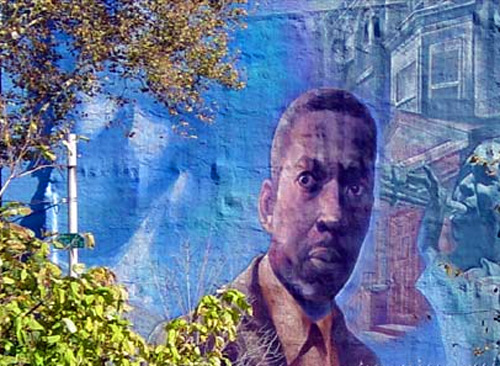
Some -- many, perhaps -- of those arrivals latched onto him here. McCoy Tyner, the pianist, is the most famous. Tyner spent hours on 33rd Street; Coltrane
offered him a job early, well before he'd organized his own quartet. Rashied Ali, a stalwart of the Philly scene, would sit in Fairmount Park in the late 1950s
and listen while Coltrane practiced across the street, on the third floor.
Back from WWII, Coltrane used the GI Bill to attend the Granoff School at 17th and Chestnut. Isadore Granoff, who died in 2000, was a Jewish immigrant from the
Ukraine who began himself as a Philly teenager giving violin lessons. Coltrane's capacity to make use -- absorb and reinterpret -- reminds me of a great city on
all cylinders: it's hungry for all the talent it can get.
–Nathaniel Popkin
nathaniel.popkin@gmail.com
For more on The Possible City, please see HERE.
For Nathaniel Popkin archives, please see HERE, or visit his web site HERE.
* * *
B Love. Note: John Coltrane was one of my earliest Philadelphia inspirations as well. The Impulse Years series was in heavy rotation in my latter days in
college, just before it was stolen with a tower of CDs, a Sony Playstation (first version), a VCR and a camera. (It was college, what can ya do?)
Anyway, Coltrane. Jazz is often so complex that casual music fans just don't bother with it, and even the most dedicated music fans sometimes hit a brick wall
with the likes of On the Corner by Miles Davis and Coltrane's Meditations. But the folks who get their first taste of jazz through Coltrane often
find themselves at "My Favorite Things".
Where "Take the A-Train" might be the "Like a Rolling Stone" of the jazz scene, "My Favorite Things" could be considered the Hendrix version of "All Along the
Watchtower" in that it took an existing song (Rodgers & Hammerstein's 1959 song from the Broadway production The Sound of Music) and perfected it. On the whole,
Julie Andrews' performance of the song in the 1965 movie may be more recognized, but the 1960 recording by Coltrane's quartet (including McCoy Tyner, Elvin Jones
and Steve Davis) and its subsequent renditions are Coltrane's signature number, especially this time of year.
All this in mind, let's heat up some mulled wine, crank this yank on YouTube and get on down to My Favorite Things from Germany in 1961 with Coltrane, Tyner,
Dolphy, Jones and Workman.
–B Love
|
   
17 December 07: Who is your daddy, or
The Northeast Extension contest is over
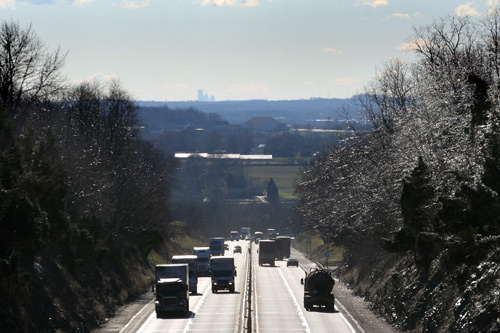
(Click it, make it bigger.)
A big Philly Skyline congratulations to the winner of the long standing long distance started way back in July (23 July 07: Philly
Skyline: far out, man): B Love from Fishtown (by way of G-Ho)! B Love submitted this photo taken this morning from the Ridge Road (PA-563) overpass above the PA
Turnpike Northeast Extension between the Quakertown and Lansdale exits. (MAP.) A six pack of Yards Philly Pale Ale will be presented by B Love to B Love, most likely this evening, or perhaps right now.
An assist goes to one CDoc for corroborating the location of Ridge Road on short notice. Word.
Anyway, there it is, your Philly Skyline, approximately 32 miles from City Hall as the crow flies, a couple miles farther than the Delaware Memorial Bridge, the
previous farthest distance I've seen the skyline. The Ridge Road overpass's closest town is Salford, with an elevation of 384'. The center of Center City is
roughly 40' above sea level, so in those 32 miles you rise over 340', or the height of the Inquirer Building. ("Bee Love, you're on some building geek stuff
here.") Guilty.
Yes but anyhoo, while the far out skyline is the topic of the day, another assist goes to Lauren from Frankford for the view below, your Philly Skyline Olney
Skyline. The Oak Lane Reservoir, at 5th Street and 65th Avenue, provides a seven mile view from the nice homes on the north side. This is just up the street from
that. Both of these PSPSs are also seen in the standard 900 x 600 pixel format of the still growing Comcast Center
section.
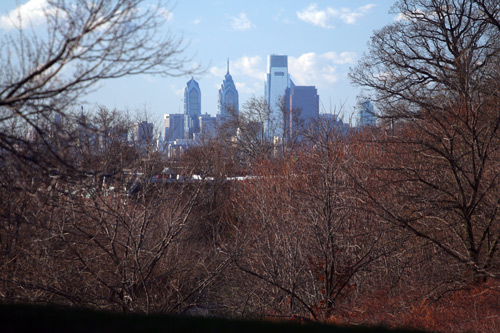
–B Love
|
16 December 07: BRRRR
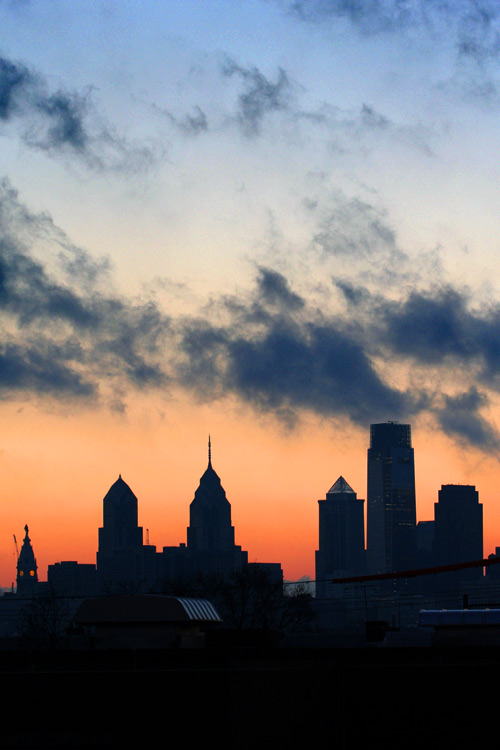
Eagles win in Dallas, Alycia Lane's arrested for punching a New York City cop, the President's House site has a newer, better design, and the Jersey Shore is
covered in sea foam . . . but the big story this weekend: baby it's COLD outside!
Click that frigid photo there for the latest round of Comcast updates from the weekend.
But most importantly: THANK YOU ALL who took time out of your office holiday parties to spend a little time with the calendar crew on Friday night. Good
times were had by all, and the good times were rounded out . . . with a lamb sandwich (right after the foie gras protesters left).
If you were unable to make it and you'd still like to purchase a calendar, why, stop on by Conspiracy, or what the hey, just click RIGHT HERE to buy it online.
THANKS EVERYBODEEEEEEEE!
–B Love
|
|





































